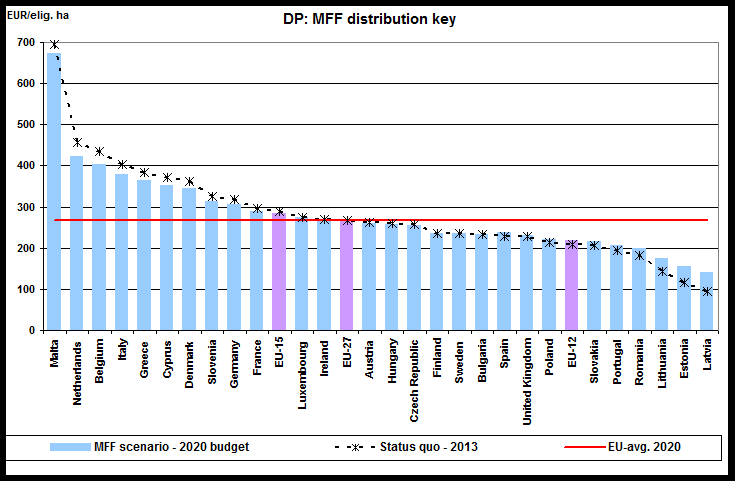The Commission’s impact assessment of the range of changes to direct payments included in its draft legislative proposals provide useful additional detail on the economic impacts to be expected from these changes and thus their political feasibility. The impact analysis has yet to be released officially but the relevant annex of the draft assessment can be found here.
Annex 3 of the impact assessment (IA) addresses all of the proposed changes in Pillar 1: greater convergence between Member States; the move toward flat rate payments within Member States or regions; additional income support in less favoured areas; capping of payments; the small farmer scheme; specific support for young farmers; a better definition of ‘active farmers’; as well as coupled aids (the ‘green’ payment option is evaluated in Annex 2 of the IA).
The IA considers a variety of options on which to base greater convergence of payments between Member States. In my previous review of the draft legislative proposals, I commented on the very limited nature of the convergence implied by the favoured mechanism, to reduce by one third the gap between existing payments per hectare and 90% of the EU average. This limited effect is confirmed in the impact assessment, which calculates that the redistribution would amount to just €738 million out of a total budget of €42.8 billion! The following graph, taken from the impact assessment, illustrates how this would play out at the Member State level.
 Redistribution between MS – Pragmatic approach with MFF distribution key
Redistribution between MS – Pragmatic approach with MFF distribution keyThe simulations using so-called ‘objective criteria’ underline why this pragmatic approach was adopted for the draft legislative proposals. Objective criteria could include GDP per head, the amount of AWU’s (Agricultural Work Units) or gross value added in agriculture/AWU (for economic criteria) or the area in less favoured areas, Natura 2000 zones or area under permanent pasture (for environmental criteria). Under one version using objective criteria for redistribution, the amount redistributed could amount to €4.5 billion, ‘which is likely to make it politically unacceptable for many Member States to agree to such a redistribution’ as the IA notes.
The IA goes into detail on the likely impact of a uniform flat rate payment within Member States on the distribution of payments by type of farming within MS. In France, for example, combining the EU-wide redistribution implied by the ‘one third reduction in the 90% gap’ rule with a uniform flat rate payment on a national basis would reduce Net Value Added per AWU on arable farms by, on average, 11%, by 7% on mixed farms, and by 1% on dairy farms, but would increase it by a massive 24% on other livestock farms. This redistribution is due, partly, to the inclusion of ‘naked land’ in the eligible area and partly to the reduction in the disparities under the historic basis for the Single Farm Payment.
Interestingly, the Commission notes that the move to a regional model is likely to increase the rate of capitalisation of support in land prices. This is because the flexibility for activating entitlements with additional eligible land is reduced due to the existence of only a very limited amount of ‘naked’ land and the absence of differences in the entitlement level in the regional model. If this argument is correct, it means that less of the payment will stay with the farmer and more will end up in the hands of the owners of land, particularly with rental arrangements.
The IA has also simulated the impact of capping although it admits that the FADN database used for this exercise is not very reliable because, as a sample survey, it may not well capture the very small number of very large farms in some Member States. Using the option contained in the draft legislative proposals (fixed ceiling of €300,000 with mitigation by 100% of wages), the overall amount modulated to Pillar 2 at EU-27 level would be 0.8%. Higher percentages would be involved in some Member States (Bulgaria 5.4%, Hungary 2.8% Romania 1.7%, Slovakia 1.7%, UK 3.8%). Interestingly, neither Germany (with its large farms in East Germany) nor the Czech Republic would be particularly affected by this measure.

